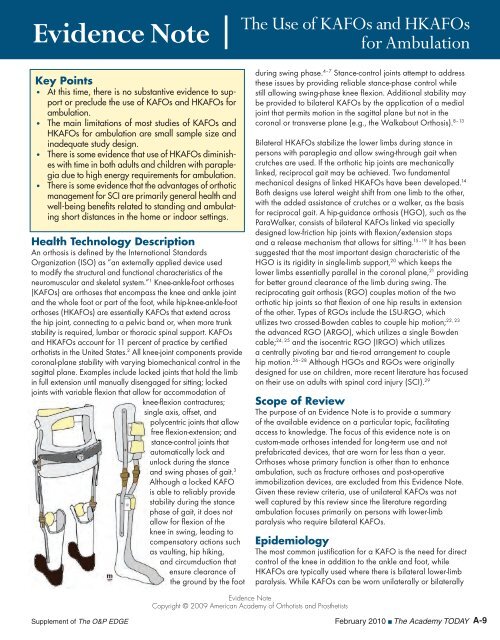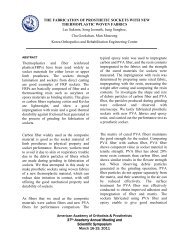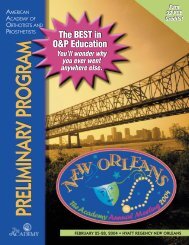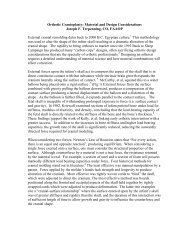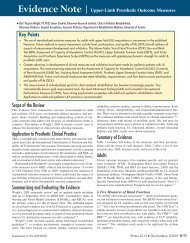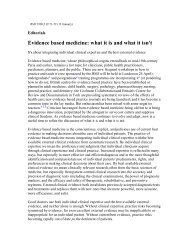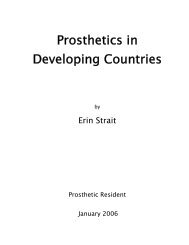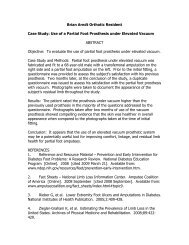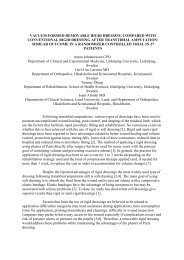Evidence Note: The Use of KAFOs and HKAFOs for Ambulation
Evidence Note: The Use of KAFOs and HKAFOs for Ambulation
Evidence Note: The Use of KAFOs and HKAFOs for Ambulation
Create successful ePaper yourself
Turn your PDF publications into a flip-book with our unique Google optimized e-Paper software.
<strong>Evidence</strong> <strong>Note</strong><br />
Key Points<br />
• At this time, there is no substantive evidence to support<br />
or preclude the use <strong>of</strong> <strong>KAFOs</strong> <strong>and</strong> H<strong>KAFOs</strong> <strong>for</strong><br />
ambulation.<br />
• <strong>The</strong> main limitations <strong>of</strong> most studies <strong>of</strong> <strong>KAFOs</strong> <strong>and</strong><br />
H<strong>KAFOs</strong> <strong>for</strong> ambulation are small sample size <strong>and</strong><br />
inadequate study design.<br />
• <strong>The</strong>re is some evidence that use <strong>of</strong> H<strong>KAFOs</strong> diminishes<br />
with time in both adults <strong>and</strong> children with paraplegia<br />
due to high energy requirements <strong>for</strong> ambulation.<br />
• <strong>The</strong>re is some evidence that the advantages <strong>of</strong> orthotic<br />
management <strong>for</strong> SCI are primarily general health <strong>and</strong><br />
well-being benefits related to st<strong>and</strong>ing <strong>and</strong> ambulating<br />
short distances in the home or indoor settings.<br />
Health Technology Description<br />
An orthosis is defined by the International St<strong>and</strong>ards<br />
Organization (ISO) as “an externally applied device used<br />
to modify the structural <strong>and</strong> functional characteristics <strong>of</strong> the<br />
neuromuscular <strong>and</strong> skeletal system.” 1 Knee-ankle-foot orthoses<br />
(<strong>KAFOs</strong>) are orthoses that encompass the knee <strong>and</strong> ankle joint<br />
<strong>and</strong> the whole foot or part <strong>of</strong> the foot, while hip-knee-ankle-foot<br />
orthoses (H<strong>KAFOs</strong>) are essentially <strong>KAFOs</strong> that extend across<br />
the hip joint, connecting to a pelvic b<strong>and</strong> or, when more trunk<br />
stability is required, lumbar or thoracic spinal support. <strong>KAFOs</strong><br />
<strong>and</strong> H<strong>KAFOs</strong> account <strong>for</strong> 11 percent <strong>of</strong> practice by certified<br />
orthotists in the United States. 2 All knee-joint components provide<br />
coronal-plane stability with varying biomechanical control in the<br />
sagittal plane. Examples include locked joints that hold the limb<br />
in full extension until manually disengaged <strong>for</strong> sitting; locked<br />
joints with variable flexion that allow <strong>for</strong> accommodation <strong>of</strong><br />
knee-flexion contractures;<br />
single axis, <strong>of</strong>fset, <strong>and</strong><br />
polycentric joints that allow<br />
free flexion-extension; <strong>and</strong><br />
stance-control joints that<br />
automatically lock <strong>and</strong><br />
unlock during the stance<br />
<strong>and</strong> swing phases <strong>of</strong> gait. 3<br />
Although a locked KAFO<br />
is able to reliably provide<br />
stability during the stance<br />
phase <strong>of</strong> gait, it does not<br />
allow <strong>for</strong> flexion <strong>of</strong> the<br />
knee in swing, leading to<br />
compensatory actions such<br />
as vaulting, hip hiking,<br />
<strong>and</strong> circumduction that<br />
ensure clearance <strong>of</strong><br />
the ground by the foot<br />
<strong>The</strong> <strong>Use</strong> <strong>of</strong> <strong>KAFOs</strong> <strong>and</strong> H<strong>KAFOs</strong><br />
<strong>for</strong> <strong>Ambulation</strong><br />
<strong>Evidence</strong> <strong>Note</strong><br />
Copyright © 2009 American Academy <strong>of</strong> Orthotists <strong>and</strong> Prosthetists<br />
during swing phase. 4–7 Stance-control joints attempt to address<br />
these issues by providing reliable stance-phase control while<br />
still allowing swing-phase knee flexion. Additional stability may<br />
be provided to bilateral <strong>KAFOs</strong> by the application <strong>of</strong> a medial<br />
joint that permits motion in the sagittal plane but not in the<br />
coronal or transverse plane (e.g., the Walkabout Orthosis). 8–13<br />
Bilateral H<strong>KAFOs</strong> stabilize the lower limbs during stance in<br />
persons with paraplegia <strong>and</strong> allow swing-through gait when<br />
crutches are used. If the orthotic hip joints are mechanically<br />
linked, reciprocal gait may be achieved. Two fundamental<br />
mechanical designs <strong>of</strong> linked H<strong>KAFOs</strong> have been developed. 14<br />
Both designs use lateral weight shift from one limb to the other,<br />
with the added assistance <strong>of</strong> crutches or a walker, as the basis<br />
<strong>for</strong> reciprocal gait. A hip-guidance orthosis (HGO), such as the<br />
ParaWalker, consists <strong>of</strong> bilateral <strong>KAFOs</strong> linked via specially<br />
designed low-friction hip joints with flexion/extension stops<br />
<strong>and</strong> a release mechanism that allows <strong>for</strong> sitting. 15–19 It has been<br />
suggested that the most important design characteristic <strong>of</strong> the<br />
HGO is its rigidity in single-limb support, 20 which keeps the<br />
lower limbs essentially parallel in the coronal plane, 21 providing<br />
<strong>for</strong> better ground clearance <strong>of</strong> the limb during swing. <strong>The</strong><br />
reciprocating gait orthosis (RGO) couples motion <strong>of</strong> the two<br />
orthotic hip joints so that flexion <strong>of</strong> one hip results in extension<br />
<strong>of</strong> the other. Types <strong>of</strong> RGOs include the LSU-RGO, which<br />
utilizes two crossed-Bowden cables to couple hip motion;<br />
Supplement <strong>of</strong> <strong>The</strong> O&P EDGE February 2010 ■ <strong>The</strong> Academy TODAY A-9<br />
22, 23<br />
the advanced RGO (ARGO), which utilizes a single Bowden<br />
cable; 24, 25 <strong>and</strong> the isocentric RGO (IRGO) which utilizes<br />
a centrally pivoting bar <strong>and</strong> tie-rod arrangement to couple<br />
hip motion. 26–28 Although HGOs <strong>and</strong> RGOs were originally<br />
designed <strong>for</strong> use on children, more recent literature has focused<br />
on their use on adults with spinal cord injury (SCI). 29<br />
Scope <strong>of</strong> Review<br />
<strong>The</strong> purpose <strong>of</strong> an <strong>Evidence</strong> <strong>Note</strong> is to provide a summary<br />
<strong>of</strong> the available evidence on a particular topic, facilitating<br />
access to knowledge. <strong>The</strong> focus <strong>of</strong> this evidence note is on<br />
custom-made orthoses intended <strong>for</strong> long-term use <strong>and</strong> not<br />
prefabricated devices, that are worn <strong>for</strong> less than a year.<br />
Orthoses whose primary function is other than to enhance<br />
ambulation, such as fracture orthoses <strong>and</strong> post-operative<br />
immobilization devices, are excluded from this <strong>Evidence</strong> <strong>Note</strong>.<br />
Given these review criteria, use <strong>of</strong> unilateral <strong>KAFOs</strong> was not<br />
well captured by this review since the literature regarding<br />
ambulation focuses primarily on persons with lower-limb<br />
paralysis who require bilateral <strong>KAFOs</strong>.<br />
Epidemiology<br />
<strong>The</strong> most common justification <strong>for</strong> a KAFO is the need <strong>for</strong> direct<br />
control <strong>of</strong> the knee in addition to the ankle <strong>and</strong> foot, while<br />
H<strong>KAFOs</strong> are typically used where there is bilateral lower-limb<br />
paralysis. While <strong>KAFOs</strong> can be worn unilaterally or bilaterally
as required, use <strong>of</strong> unilateral H<strong>KAFOs</strong> is rare <strong>and</strong> limited to<br />
short-term application following hip arthroplasty to allow <strong>for</strong><br />
protected walking. 3 <strong>The</strong> principal impairments addressed by<br />
<strong>KAFOs</strong> are paresis or paralysis <strong>of</strong> the muscles controlling the<br />
knee joint, upper motor-neuron lesions resulting in hypertonicity<br />
(spasticity) <strong>of</strong> the lower limb, or loss <strong>of</strong> structural integrity <strong>of</strong> the<br />
hip or knee joints. A literature review <strong>of</strong> <strong>KAFOs</strong> <strong>and</strong> H<strong>KAFOs</strong><br />
<strong>for</strong> ambulation indicated that KAFO users include children<br />
with Duchenne muscular dystrophy (DMD) <strong>and</strong> persons with a<br />
diagnosis <strong>of</strong> polio, post-polio syndrome, or stroke; while users<br />
<strong>of</strong> H<strong>KAFOs</strong> include adults with SCI or paraplegia <strong>and</strong> children<br />
with myelomeningocele. 29<br />
Clinical Effectiveness<br />
Three systematic reviews regarding the use <strong>of</strong> <strong>KAFOs</strong> <strong>and</strong><br />
H<strong>KAFOs</strong> <strong>for</strong> ambulation were identified. 30–32<br />
As part <strong>of</strong> the Spinal Cord Injury Rehabilitation <strong>Evidence</strong><br />
project, Lam et al. 32 reviewed 14 studies that reported the<br />
effects <strong>of</strong> gait training with <strong>KAFOs</strong> <strong>and</strong> H<strong>KAFOs</strong> in people with<br />
complete <strong>and</strong> incomplete SCI, <strong>and</strong> seven studies that examined<br />
the combined effect <strong>of</strong> RGOs <strong>and</strong> functional electrical<br />
stimulation (FES) on functional ambulation in people with<br />
complete SCI. <strong>The</strong>y concluded that limited evidence suggests<br />
the benefits <strong>of</strong> orthotic management alone on functional<br />
ambulation are primarily <strong>for</strong> people with incomplete spinal<br />
lesions. <strong>The</strong> advantages <strong>of</strong> orthotic management are primarily<br />
the general health <strong>and</strong> well-being benefits related to st<strong>and</strong>ing<br />
<strong>and</strong> ambulating short distances in the home or indoor settings.<br />
<strong>The</strong>re is limited evidence that a combined approach <strong>of</strong> orthoses<br />
<strong>and</strong> FES results in additional benefit to functional ambulation in<br />
paraplegic patients with complete SCI. 32<br />
Ijzerman et al. 30 reviewed 12 comparative trials <strong>of</strong> H<strong>KAFOs</strong><br />
with <strong>and</strong> without FES <strong>for</strong> adults with complete thoracic lesions<br />
<strong>and</strong> reported that all the studies were internally invalid due to<br />
inadequate study design (simple within-subject comparisons<br />
without r<strong>and</strong>omization <strong>of</strong> orthosis testing order) <strong>and</strong> lack <strong>of</strong><br />
statistical power (small, heterogenous study populations).<br />
Bakker et al. 31 reviewed nine controlled <strong>and</strong> uncontrolled<br />
clinical trials <strong>and</strong> case studies regarding intervention with<br />
<strong>KAFOs</strong> <strong>for</strong> children with DMD. <strong>The</strong>y also noted that the<br />
scientific strength <strong>of</strong> the reviewed studies was poor but<br />
nevertheless concluded that use <strong>of</strong> <strong>KAFOs</strong> in the management<br />
<strong>of</strong> DMD can prolong assisted walking <strong>and</strong> st<strong>and</strong>ing. It<br />
remained uncertain whether <strong>KAFOs</strong> prolong “functional<br />
walking” because most studies were vague on what constitutes<br />
functional walking.<br />
In 2006, the American Academy <strong>of</strong> Orthotists <strong>and</strong> Prosthetists<br />
(the Academy) held a state <strong>of</strong> the science conference on the<br />
use <strong>of</strong> <strong>KAFOs</strong> <strong>and</strong> H<strong>KAFOs</strong> to assist with ambulation (SSC7). 33<br />
<strong>The</strong> literature review <strong>for</strong> this meeting identified two r<strong>and</strong>omized<br />
control trials <strong>and</strong> included 27 cross-sectional studies published<br />
between 1995 <strong>and</strong> 2004. 29 <strong>The</strong> review concluded that though<br />
<strong>Evidence</strong> <strong>Note</strong><br />
Copyright © 2009 American Academy <strong>of</strong> Orthotists <strong>and</strong> Prosthetists<br />
a reasonable amount <strong>of</strong> literature had been written regarding<br />
<strong>KAFOs</strong> <strong>and</strong> H<strong>KAFOs</strong>, the level <strong>of</strong> evidence regarding their use<br />
<strong>for</strong> ambulation was generally low. 29 <strong>The</strong>re was some evidence<br />
that use <strong>of</strong> H<strong>KAFOs</strong> diminishes with time in both adults <strong>and</strong><br />
children with paraplegia <strong>and</strong> that when orthoses are used, they<br />
are used mostly <strong>for</strong> therapeutic purposes. 11, 34–37 <strong>The</strong>re was also<br />
some evidence that walking speed is slow <strong>and</strong> energy cost high<br />
in people with paraplegia regardless <strong>of</strong> orthotic device used. 12,<br />
28, 38–46<br />
<strong>The</strong>re are as yet no reviews regarding stance-control orthoses<br />
(SCOs). 29 To date, there have been seven cross-sectional<br />
studies, 5–7, 47–50 ten case studies, 4, 51–59 <strong>and</strong> two technical<br />
notes. 60, 61 Three have evaluated gait with the Horton’s Stance<br />
Control Orthotic Knee Joint (SCOKJ), 4, 6, 55 six describe<br />
development <strong>and</strong> evaluation <strong>of</strong> the dynamic knee-brace<br />
system (DKBS), 5, 49, 50, 53, 54, 62 <strong>and</strong> two describe development<br />
<strong>and</strong> application <strong>of</strong> an electromechanical stance-control KAFO<br />
(SCKAFO). 57, 63 A single case study describes attempts to<br />
combine stance-control joints with an RGO. 58 <strong>The</strong> majority <strong>of</strong><br />
these studies have been in able-bodied persons or persons<br />
with unilateral limb weakness resulting from conditions such as<br />
polio. Preliminary studies suggest that providing stance control<br />
may decrease compensatory maneuvers (vaulting, hip hiking)<br />
<strong>and</strong> energy expenditure compared to walking with a locked<br />
4–7, 47, 51, 53, 55, 57<br />
knee.<br />
Safety<br />
It is recommended that qualified orthotists should contribute to<br />
the assessment <strong>and</strong> prescription <strong>of</strong> orthoses <strong>and</strong> be specifically<br />
responsible <strong>for</strong> manufacture <strong>and</strong> delivery <strong>of</strong> orthotic devices. 64<br />
An orthotist is an allied health pr<strong>of</strong>essional who is specifically<br />
trained <strong>and</strong> educated to provide or manage the provision <strong>of</strong><br />
a custom-designed, fabricated, modified, <strong>and</strong> fitted external<br />
orthosis to a patient. 65 Practitioners who successfully complete<br />
the education, experience, <strong>and</strong> examination requirements<br />
prescribed by an accrediting body become certified orthotists.<br />
Certification indicates that the orthotist has met established<br />
st<strong>and</strong>ards <strong>and</strong> has the qualifications required to render orthotic<br />
services. A certified orthotist is the best person to ensure safe<br />
provision <strong>and</strong> use <strong>of</strong> a KAFO or HKAFO.<br />
Economic Implications<br />
No published studies examining the cost effectiveness <strong>of</strong> <strong>KAFOs</strong><br />
<strong>and</strong> H<strong>KAFOs</strong> were identified. A review <strong>of</strong> Medicare payment<br />
data <strong>for</strong> 2007 66 shows that the allowable base rate <strong>of</strong> a single<br />
custom-fabricated KAFO ranged from $734–$3,289, while the<br />
allowable cost <strong>for</strong> an RGO was approximately $8,306 using the<br />
suggested coding <strong>for</strong> an ARGO 67 as an example.<br />
Future Research<br />
Designing adequate studies to investigate the effect <strong>of</strong><br />
<strong>KAFOs</strong> <strong>and</strong> H<strong>KAFOs</strong> on ambulation is challenging due<br />
to the heterogeneous populations that use these devices<br />
<strong>and</strong> the heterogeneity within each population. It has been<br />
recommended that r<strong>and</strong>omized crossover interrupted time<br />
A-10 <strong>The</strong> Academy TODAY ■ February 2010 Supplement <strong>of</strong> <strong>The</strong> O&P EDGE
series trials be used to improve the internal validity <strong>and</strong><br />
statistical power <strong>of</strong> future research regarding <strong>KAFOs</strong> <strong>and</strong><br />
H<strong>KAFOs</strong> <strong>for</strong> ambulation. 30 Furthermore, Fatone 29 indicated that<br />
the population being evaluated (diagnosis, time since injury,<br />
lesion level, whether a lesion is complete or not, residual muscle<br />
function, prior experience with orthosis, training provided,<br />
type <strong>of</strong> gait pattern used) <strong>and</strong> the orthosis being used must be<br />
adequately described in order <strong>for</strong> study data to be interpreted<br />
<strong>and</strong> the in<strong>for</strong>mation generalized or compared between studies.<br />
<strong>The</strong> following primary research priorities regarding use <strong>of</strong><br />
<strong>KAFOs</strong> <strong>and</strong> H<strong>KAFOs</strong> <strong>for</strong> ambulation were identified by<br />
participants <strong>of</strong> SSC7: 33<br />
• Identify <strong>and</strong>/or develop st<strong>and</strong>ardized subjective <strong>and</strong> objective<br />
outcome measures.<br />
• Investigate the short- <strong>and</strong> long-term effects <strong>of</strong> KAFO <strong>and</strong><br />
HKAFO use on the neuromusculoskeletal system.<br />
• Research application <strong>of</strong> SCOs.<br />
• Define the mechanical loading conditions on KAFO <strong>and</strong><br />
HKAFO devices to guide orthotic design <strong>and</strong> application.<br />
• Determine the short- <strong>and</strong> long-term effects <strong>of</strong> physi cal therapy<br />
intervention, including gait training, on outcome <strong>and</strong> acceptance<br />
<strong>of</strong> <strong>KAFOs</strong> <strong>and</strong> H<strong>KAFOs</strong>.<br />
• Measure the impact <strong>of</strong> pharmacological management on<br />
successful use <strong>of</strong> <strong>KAFOs</strong> <strong>and</strong> H<strong>KAFOs</strong> in persons with severe<br />
spasticity.<br />
Acknowledgments<br />
This <strong>Evidence</strong> <strong>Note</strong> was compiled by Stefania Fatone, PhD. This <strong>Evidence</strong> <strong>Note</strong> was made possible by the Academy through a<br />
grant (Award Number H235K080004) from the U.S. Department <strong>of</strong> Education. <strong>The</strong> contents do not necessarily represent the<br />
policy <strong>of</strong> the Department <strong>of</strong> Education, <strong>and</strong> you should not assume endorsement by the federal government. Thanks to Kathy<br />
Dodson, American Orthotic & Prosthetic Association (AOPA), <strong>for</strong> providing the 2007 Medicare payment data <strong>and</strong> Scott Magis <strong>for</strong><br />
the drawings.<br />
Suggested Citation<br />
Fatone S. <strong>Evidence</strong> <strong>Note</strong>: <strong>The</strong> <strong>Use</strong> <strong>of</strong> <strong>KAFOs</strong> <strong>and</strong> H<strong>KAFOs</strong> <strong>for</strong> <strong>Ambulation</strong>. Washington DC: American Academy <strong>of</strong> Orthotists <strong>and</strong><br />
Prosthetists. (2009)<br />
References<br />
1. International Organization <strong>for</strong> St<strong>and</strong>ardization. ISO 8549-1:1989 Prosthetics <strong>and</strong> Orthotics—Vocabulary. General terms <strong>for</strong> external limb prostheses <strong>and</strong> orthoses.<br />
Geneva, Switzerl<strong>and</strong>; 1989.<br />
2. Whiteside S, Allen M, Barringer W, et al. Practice analysis <strong>of</strong> certified practitioners in the disciplines <strong>of</strong> orthotics <strong>and</strong> prosthetics. Alex<strong>and</strong>ria, VA: American Board<br />
<strong>for</strong> Certification in Orthotics <strong>and</strong> Prosthetics, Inc.; 2007.<br />
3. Michael JW. Lower limb orthoses. In: Hsu J, Michael J, Fisk J, eds. AAOS Atlas <strong>of</strong> Orthoses <strong>and</strong> Assistive Devices. Philadelphia, PA: Mosby Elsevier;<br />
2008:343–355.<br />
4. Hebert JS, Liggins AB. Gait evaluation <strong>of</strong> an automatic stance-control knee orthosis in a patient with postpoliomyelitis. Arch Phys Med Rehabil. 2005;86:1676–<br />
1680.<br />
5. Irby SE, Bernhardt KA, Kaufman KR. Gait <strong>of</strong> stance control orthosis users: <strong>The</strong> Dynamic Knee Brace System. Prosthet Orthot Int. 2005;29:269–282.<br />
6. Zissimopoulos A, Fatone S, Gard S. Biomechanical <strong>and</strong> energetic effects <strong>of</strong> a stance-control orthotic knee joint. J Rehabil Res Dev. 2007;44:503–514.<br />
7. Hwang S, Kang S, Cho K, Kim Y. Biomechanical effect <strong>of</strong> electromechanical knee–ankle–foot orthosis on knee joint control in patients with poliomyelitis. Med<br />
Biol Eng Comput. 2008;46:541–549.<br />
8. Saitoh E, Suzuki T, Sonoda S, et al. Clinical experience with a new hip–knee–ankle–foot orthotic system using a medial single hip joint <strong>for</strong> paraplegic st<strong>and</strong>ing<br />
<strong>and</strong> walking. Am J Phys Med Rehabil. 1996;75:198–203.<br />
9. Harvey LA, Newton-John T, Davis GM, et al. A comparison <strong>of</strong> the attitude <strong>of</strong> paraplegic individuals to the walkabout orthosis <strong>and</strong> the isocentric reciprocal gait<br />
orthosis. Spinal Cord. 1997;35:580–584.<br />
10. Harvey LA, Smith MB, Davis GM, Engel S. Functional outcomes attained by T9–12 paraplegic patients with the walkabout <strong>and</strong> the isocentric reciprocal gait<br />
orthoses. Arch Phys Med Rehabil. 1997;78:706–711.<br />
11. Middleton JW, Yeo JD, Blanch L, et al. Clinical evaluation <strong>of</strong> a new orthosis, the ‘walkabout’, <strong>for</strong> restoration <strong>of</strong> functional st<strong>and</strong>ing <strong>and</strong> short distance mobility in<br />
spinal paralysed individuals. Spinal Cord. 1997;35:574–579.<br />
12. Harvey LA, Davis GM, Smith MB, Engel S. Energy expenditure during gait using the walkabout <strong>and</strong> isocentric reciprocal gait orthoses in persons with paraplegia.<br />
Arch Phys Med Rehabil 1998;79:945–949.<br />
13. Middleton JW, Fisher W, Davis GM, Smith RM. A medial linkage orthosis to assist ambulation after spinal cord injury. Prosthet Orthot Int. 1998;22:258–264.<br />
14. Campbell J. Linked hip–knee–ankle–foot orthoses designed <strong>for</strong> reciprocal gait. J Prosthet Orthot. 2006;18:204–208.<br />
15. Rose GK. <strong>The</strong> principles <strong>and</strong> practice <strong>of</strong> hip guidance articulations. Prosthet Orthot Int. 1979;3:37–43.<br />
16. Butler PB, Major RE, Patrick JH. <strong>The</strong> technique <strong>of</strong> reciprocal walking using the hip guidance orthosis (HGO) with crutches. Prosthet Orthot Int. 1984;8:33–38.<br />
17. Butler PB, Major R. <strong>The</strong> ParaWalker: a rational approach to the provision <strong>of</strong> reciprocal ambulation <strong>for</strong> paraplegic patients. Physiotherapy. 1987;73:393–397.<br />
18. Patrick J. Walking restoration <strong>for</strong> complete adult thoracic level paraplegics. Int J Rehabil Res. 1987;10:301.<br />
19. Moore P. <strong>The</strong> ParaWalker: walking <strong>for</strong> thoracic paraplegics. Physiotherapy Practice. 1988;4:18–22.<br />
20. Whittle MW, Cochrane GM. A comparative evaluation <strong>of</strong> the Hip Guidance Orthosis (HGO) <strong>and</strong> the Reciprocating Gait Orthosis (RGO). Health Equipment<br />
In<strong>for</strong>mation No. 192, NHS Procurement Directorate, Department <strong>of</strong> Health, HM Govt, London, UK. 1989.<br />
21. Jefferson RJ, Whittle MW. Per<strong>for</strong>mance <strong>of</strong> three walking orthoses <strong>for</strong> the paralysed: a case study using gait analysis. Prosthet Orthot Int. 1990;14:103–110.<br />
22. Douglas R, Larson PF, D’Ambrosia R, McCall RE. <strong>The</strong> LSU Reciprocating Gait Orthosis. Orthop. 1983;6:834–839.<br />
23. Beckman J. <strong>The</strong> Louisiana State University reciprocating gait orthosis. Physiotherapy. 1987;73:386 –391.<br />
24. Lissons M. Advanced reciprocating gait orthosis in paraplegic patients. Paper presented at the 7th World Congress <strong>of</strong> the International Society <strong>for</strong> Prosthetics<br />
<strong>and</strong> Orthotics. Chicago, IL; June 28–July 3, 1992.<br />
<strong>Evidence</strong> <strong>Note</strong><br />
Copyright © 2009 American Academy <strong>of</strong> Orthotists <strong>and</strong> Prosthetists<br />
Supplement <strong>of</strong> <strong>The</strong> O&P EDGE February 2010 ■ <strong>The</strong> Academy TODAY A-11
25. Lissens M, Peeraer L, Tirez B, et al. Advanced reciprocating gait orthosis (ARGO) in paraplegic patients (abstract). Eur J Phys Med Rehabil. 1993;3:147.<br />
26. Motloch WM. Principles <strong>of</strong> orthotic management <strong>for</strong> child <strong>and</strong> adult paraplegia <strong>and</strong> clinical experience with the Isocentric RGO. Paper presented at the 7th<br />
World Congress <strong>of</strong> the International Society <strong>for</strong> Prosthetics <strong>and</strong> Orthotics; June 28–July 3, 1992; Chicago, IL.<br />
27. Davidson H. <strong>The</strong> isocentric reciprocating gait orthosis. APO Newsletter. 1994;1:12–15.<br />
28. Winchester PK, Carollo JJ, Parekh RN, et al. A comparison <strong>of</strong> paraplegic gait per<strong>for</strong>mance using two types <strong>of</strong> reciprocating gait orthoses. Prosthet Orthot Int.<br />
1993;17:101–106.<br />
29. Fatone S. A review <strong>of</strong> the literature pertaining to <strong>KAFOs</strong> <strong>and</strong> H<strong>KAFOs</strong> <strong>for</strong> ambulation. J Prosthet Orthot. 2006;18:137–168.<br />
30. Ijzerman MJ, Baardman G, Hermens HJ, et al. Comparative trials on hybrid walking systems <strong>for</strong> people with paraplegia: an analysis <strong>of</strong> study methodology.<br />
Prosthet Orthot Int. 1999;23:260–273.<br />
31. Bakker JP, de Groot IJ, Beckerman H, et al. <strong>The</strong> effects <strong>of</strong> knee–ankle–foot orthoses in the treatment <strong>of</strong> Duchenne muscular dystrophy: review <strong>of</strong> the literature.<br />
Clin Rehabil. 2000;14:343–359.<br />
32. Lam T, Wolfe D, Hsieh J, et al. Lower Limb Rehabilitation Following Spinal Cord Injury. In: Eng J, Teasell R, Miller W, Wolfe D, Townson A, Hsieh J, Konnyu K,<br />
Connolly S, Foulon B, Aubut J, eds. Spinal Cord Injury Rehabilitation <strong>Evidence</strong>. Vancouver: SCI Solutions Network; 2008:6.1–6.41.<br />
33. American Academy <strong>of</strong> Orthotists <strong>and</strong> Prosthetists. Proceedings: Knee–Ankle–Foot Orthoses <strong>for</strong> <strong>Ambulation</strong>. Official Findings <strong>of</strong> the State-<strong>of</strong>-the-Science Conference;<br />
February 11–12, 2006; Chicago, IL.<br />
34. Franceschini M, Baratta S, Zampolini M, et al. Reciprocating gait orthoses: a multicenter study <strong>of</strong> their use by spinal cord injured patients. Arch Phys Med Rehabil.<br />
1997;78:582–586.<br />
35. Jaspers P, Peeraer L, Van Petegem W, Van der Perre G. <strong>The</strong> use <strong>of</strong> an advanced reciprocating gait orthosis by paraplegic individuals: a follow–up study. Spinal<br />
Cord. 1997;35:585–589.<br />
36. Nene A. Paraplegic locomotion: A review. Spinal Cord. 1996;34:507–524.<br />
37. Waters RL, Mulroy S. <strong>The</strong> energy expenditure <strong>of</strong> normal <strong>and</strong> pathologic gait. Gait Posture. 1999;9:207–231.<br />
38. Ijzerman MJ, Baardman G, Hermens HJ, et al. Speed dependence <strong>of</strong> crutch <strong>for</strong>ce <strong>and</strong> oxygen uptake: implications <strong>for</strong> design <strong>of</strong> comparative trials on orthoses<br />
<strong>for</strong> people with paraplegia. Arch Phys Med Rehabil. 1998;79:1408–1414.<br />
39. Ijzerman MJ, Baardman G, van H<strong>of</strong> MA, et al. Validity <strong>and</strong> reproducibility <strong>of</strong> crutch <strong>for</strong>ce <strong>and</strong> heart rate measurements to assess energy expenditure <strong>of</strong> paraplegic<br />
gait. Arch Phys Med Rehabil. 1999;80:1017–1023.<br />
40. Merritt JL, Yoshida MK. Knee–ankle–foot orthoses: indications <strong>and</strong> practical applications <strong>of</strong> long leg braces. Phys Med Rehabil State Art Rev. 2000;14:239–<br />
422.<br />
41. Waters RL, Yakura JS, Adkins RH. Gait per<strong>for</strong>mance after spinal cord injury. Clin Orthop. 1993;288:87–96.<br />
42. Clinkingbeard JR, Gersten JW, Hoehn D. Energy Cost <strong>of</strong> <strong>Ambulation</strong> in the Traumatic Paraplegic. Am J Phys Med. 1964;43:157–165.<br />
43. Merkel KD, Miller NE, Merritt JL. Energy expenditure in patients with low-, mid-, or high-thoracic paraplegia using Scott-Craig knee–ankle–foot orthoses. Mayo<br />
Clin Proc. 1985;60:165–168.<br />
44. Hirokawa S, Grimm M, Le T, et al. Energy consumption in paraplegic ambulation using the reciprocating gait orthosis <strong>and</strong> electric stimulation <strong>of</strong> the thigh muscles.<br />
Arch Phys Med Rehabil. 1990;71:687–694.<br />
45. Chantraine A, Crielaard JM, Onkelinx A, Pirnay F. Energy expenditure <strong>of</strong> ambulation in paraplegics: effects <strong>of</strong> long term use <strong>of</strong> bracing. Paraplegia.<br />
1984;22:173–181.<br />
46. Nene AV, Patrick JH. Energy cost <strong>of</strong> paraplegic locomotion with the ORLAU ParaWalker. Paraplegia 1989;27:5–18.<br />
47. Suga T, Kameyama O, Ogawa R, et al. Newly designed computer controlled knee–ankle–foot orthosis (Intelligent Orthosis). Prosthet Orthot Int. 1998;22:230–<br />
239.<br />
48. Tokuhara Y, Kameyama O, Kubota T, et al. Biomechanical study <strong>of</strong> gait using an intelligent brace. J Orthop Sci. 2000;5:342–348.<br />
49. Irby SE, Bernhardt KA, Kaufman KR. Gait changes over time in stance control orthosis users. Prosthet Orthot Int. 2007;31:353–361.<br />
50. Bernhardt KA, Irby SE, Kaufman KR. Consumer opinions <strong>of</strong> a stance control knee orthosis. Prosthet Orthot Int. 2006;30:246–256.<br />
51. Lehmann JF, Stonebridge JB. Knee lock device <strong>for</strong> knee ankle orthoses <strong>for</strong> spinal cord injured patients: an evaluation. Arch Phys Med Rehabil. 1978;59:207–<br />
211.<br />
52. Kagaya H, Shimada Y, Sato K, et al. An electrical knee lock system <strong>for</strong> functional electrical stimulation. Arch Phys Med. Rehabil. 1996;77:870–873.<br />
53. Kaufman KR, Irby SE, Mathewson JW, et al. Energy-efficient knee–ankle foot orthosis: a case study. J Prosthet Orthot. 1996;8(3):79.<br />
54. Irby SE, Kaufman KR, Wirta RW, Sutherl<strong>and</strong> DH. Optimization <strong>and</strong> application <strong>of</strong> a wrap-spring clutch to a dynamic knee–ankle–foot orthosis. IEEE Trans<br />
Rehabil Eng. 1999;7:130–134.<br />
55. McMillan A, Kendrick K, Michael J, et al. Preliminary evidence <strong>for</strong> effectiveness <strong>of</strong> a stance control orthosis. J Prosthet Ortho. 2004;16:6–15.<br />
56. Rietman JS, Goudsmit J, Meulemans D, et al. An automatic hinge system <strong>for</strong> leg orthoses. Prosthet Orthot Int. 2004;28:64–68.<br />
57. Yakimovich T, Lemaire ED, K<strong>of</strong>man J. Preliminary kinematic evaluation <strong>of</strong> a new stance-control knee–ankle–foot orthosis. Clin Biomech (Bristol, Avon).<br />
2006;21:1081–1089.<br />
58. Rasmussen A, Smith K, Damiano D. Biomechanical evaluation <strong>of</strong> the combination <strong>of</strong> bilateral stance-control knee–ankle–foot orthoses <strong>and</strong> a reciprocating gait<br />
orthosis in an adult with a spinal cord injury. J Prosthet Orthot. 2007;19:42–47.<br />
59. Moreno J, Brunetti F, Rocon E, Pons J. Immediate effects <strong>of</strong> a controllable knee ankle foot orthosis <strong>for</strong> functional compensation <strong>of</strong> gait in patients with proximal<br />
leg weakness. Med Biol Eng Comput. 2008 46:43–53.<br />
60. van Leerdam N, Kunst E. Die neue bienorthese UTX-Swing: normales gehen, kombiniert mit sicherem Stehen (New UTX-Swing orthosis: normal gait <strong>and</strong> safe<br />
st<strong>and</strong>ing) OrthopadieTechnik. 1999;6:506–515.<br />
61. Sarikaya S, Basaran A, Ortancil O, Balbaloglu O. A new modification <strong>of</strong> KAFO <strong>for</strong> assistance in knee extension. Disabil Rehabil Assist Technol 2007. 2:67–70.<br />
62. Irby SE, Kaufman KR, Mathewson JW, Sutherl<strong>and</strong> DH. Automatic control design <strong>for</strong> a dynamic knee-brace system. IEEE Trans Rehabil Eng. 1999;7:135–139.<br />
63. Yakimovich T, K<strong>of</strong>man J, Lemaire ED. Design <strong>and</strong> evaluation <strong>of</strong> a stance-control knee–ankle–foot orthosis knee joint. IEEE Trans Neur Sys Rehabil Eng.<br />
2006;14:361–369.<br />
64. Condie E, Campbell J, Martina J. Report <strong>of</strong> a consensus conference on the orthotic management <strong>of</strong> stroke patients. International Society <strong>for</strong> Prosthetics <strong>and</strong><br />
Orthotics; 2004; Copenhagen, Denmark.<br />
65. American Board <strong>for</strong> Certification in Orthotics, Prosthetics <strong>and</strong> Pedorthics. Practitioner Certification Book <strong>of</strong> Rules. Alex<strong>and</strong>ria, VA: American Board <strong>for</strong> Certification<br />
in Orthotics, Prosthetics <strong>and</strong> Pedorthics; 2003.<br />
66. Centers <strong>for</strong> Medicare <strong>and</strong> Medicaid Services (CMS). Part B Physician/Supplier Procedure Summary (PSPS) Master Record File. 2007.<br />
67. 2008—Coding <strong>for</strong> the Advanced Reciprocating Gait Orthosis (Adult ARGO 60 & 90). Liberating Technologies Inc. http://www.liberatingtech.com/products/<br />
documents/argo_l-codes_2008.pdf. Accessed: May 11, 2009.<br />
<strong>Evidence</strong> <strong>Note</strong><br />
Copyright © 2009 American Academy <strong>of</strong> Orthotists <strong>and</strong> Prosthetists<br />
A-12 <strong>The</strong> Academy TODAY ■ February 2010 Supplement <strong>of</strong> <strong>The</strong> O&P EDGE


